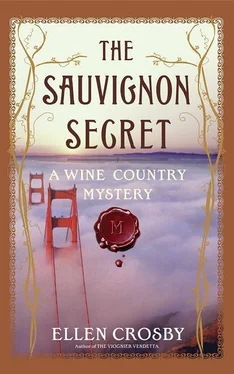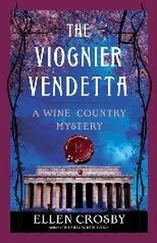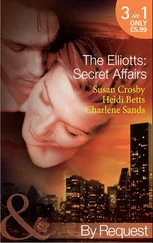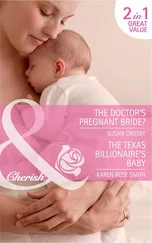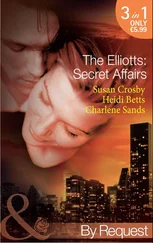“Where are we going now?” I asked.
“Santa Cruz.” He reached over and stabbed the map. “Sits at the top of Monterey Bay. Beautiful little town—fabulous beaches for surfing, very laid back, very mellow. You’re gonna love it.”
“What’s in Santa Cruz?”
“You mean who is in Santa Cruz.” He corrected me. “Allen Cantor. We’re meeting him on the Boardwalk. His choice.”
“You tell him why you want to see him?”
“Nope. Just that I wanted to ask him a few questions.” We exchanged sideways glances. “He didn’t even ask what they were. Allen owes me and he knows it.”
“I wonder if he knows anything about Teddy Fargo,” I said.
“If there’s anything to know,” Quinn said, “he does.”
The traffic was heavier as we picked up 101, the Bayshore Freeway, and left San Francisco behind. Quinn punched a button on the satellite radio. I read the display. Sixties on Six. Probably one of Harmony’s presets. Right now it was adrenaline-pumping rush-hour stuff, slipping from Jefferson Airplane into the Rolling Stones.
“I found out about Mel Racine.” He had to raise his voice above Mick Jagger and the traffic so I could hear him.
“What did you find out?” I shouted back.
“Had a series of car dealerships near Santa Cruz. Then he moved up the coast to Half Moon Bay.” His finger skittered over the map again. “See, right there? The bank he bought to turn into a wine storage vault is up for sale.”
“Oh, yeah?” I studied the map. “By the time we leave Santa Cruz, won’t the marine layer have burned off enough that we can take the coast road north to San Francisco? Looks like it goes right through Half Moon Bay. Maybe we could stop and check out that bank.”
He turned to me and grinned, singing in a loud, off-key voice, imitating Mick and telling me he didn’t get no satisfaction.
“’Cause I try … and I try,” he said, leering at me.
“I guess that’s a yes.”
He nodded and kept singing as we wove through traffic. Usually I would have joined in. But this morning as the Porsche dodged in and out of the pea-soup marine layer, I couldn’t stop wondering what was in store for us when we got to Santa Cruz and, later, Half Moon Bay.
Once we passed the high-tech Silicon Valley corridor, Quinn turned south at Los Gatos onto Highway 17 and we began climbing through the Santa Cruz Mountains. He knew the road well enough, but the sharp zigzag turns with their blind curves as we sliced through pine and redwood fog-shrouded hills meant he needed to pay attention to his driving. Our conversation ground to a halt. When we passed a sign warning motorists to turn off the air-conditioning to prevent engine boil over, I finally asked if the road was as treacherous as it seemed.
He nodded. “Lots of accidents, especially at one underpass where drivers are so busy navigating the steep curves they don’t expect a nearly horizontal switchback turn until it’s too late. It’s called the Valley Surprise.”
My own surprise was Santa Cruz itself. Quinn started talking about it, reminiscing, actually, after we left 17 where it joined Highway 1, which ran north-south along the coast. I don’t know what it was—the jaunty tilt to his chin or the sentimental softness in his voice—but I could easily imagine him as he used to be, growing up in this place that had been his idea of paradise, a well-muscled, good-looking sun god with windblown blond-flecked curls, a surf-board under one arm and a cute girl in a bikini named Tammy or Kimberly hanging on the other. The Byrds were singing “Turn, Turn, Turn” on the radio and I felt a queer tug of nostalgia for a time and place I never knew, the sun-drenched, free-spirited, live-andlet-live California of all the era-defining, generation-shaping songs that caused Penelope to become Harmony nearly half a century ago and never go back.
We’d left the mountains and the swirling marine layer behind and now were on flatter terrain, a palm- and cypress-lined street of low-rise sand-colored motels advertising cheap beach weekend rates and cable television. Quinn pulled over and reached for his phone.
I raised an eyebrow and he said, “Allen told me to call him when we were about ten minutes away from the Boardwalk.”
Their conversation lasted all of ten seconds. “Why the Boardwalk?” I asked. “Does he work there?”
“No,” he said. “I don’t know where he works. The Boardwalk’s where the amusement park is located, too. I guess that’s his way of making a joke.”
I saw the looped silhouette of a roller coaster framed between a couple of palm trees and set against a hazy, blue-white sky as we drove closer to the water.
“That’s the Hurricane,” Quinn said. “At the other end of the park by the San Lorenzo River is the Giant Dipper, the oldest wooden roller coaster on the West Coast. It’s a historic landmark now.”
“How old is it?” I asked. “If it’s a historic landmark.”
“Old, 1907,” he said. “The Boardwalk had its centenary a few years ago. The roller coaster was built in 1924. The Looff Carousel is even older—1911.”
“It looks like something from an old postcard or a sepia photograph.”
He smiled. “They’ve done a good job of keeping the vintage feel about the place. Brings in lots of families looking for something wholesome to do.”
He pulled into a municipal parking lot across the street from a gaudy Moorish-style building with a toothy shark and bright red octopus painted on either side of the arched entrance and NEPTUNE’S KINGDOM written above it.
“That’s the arcade,” Quinn said. “We’re meeting Allen at the burger place under the colonnade. I had to promise him breakfast and a beer.”
I stared at him and he shrugged.
We crossed the street and walked under a sign welcoming us to the Santa Cruz Boardwalk. Framed by dusky purple mountains, Monterey Bay gleamed silvery blue, the water calm except for a froth of surf lapping at a long expanse of beach. The amusement park, on two levels, was the retro throwback Quinn had promised, with its famous carousel, along with a Ferris wheel, pirate ship, sherbet-colored sky glider cable cars disappearing into the mist down the beach—and the Giant Dipper.
“Turn right,” Quinn said. “No rides for us today.”
The burgundy and pale gold colonnade, with its carnival-like rows of flashing lights running along the ceiling, seemed relatively quiet for a Monday morning in the middle of summer. Only a handful of the small metal tables lining the arcade railing were occupied. Quinn picked one that had a checkerboard painted on it and we sat down on two of the low welded-on bar stools to wait. The sunlight made perfect half-moon circles of each arch on the concrete walkway, the Beatles sang “Love Me Do,” and the fronds of the scalped-looking palm trees growing a few feet away in the sand rustled in the cool ocean breeze.
Quinn had taken the seat facing the Boardwalk entrance, as I’d guessed he would do. Thirty seconds later Allen Cantor came into view. I knew at once because of the tiny tightening in Quinn’s eyes and the way his body tensed—like a fighter waiting for the opening bell so he could get into the ring and demolish his opponent. His gaze flicked back at me, a coded message not to turn around. I wondered, as I suspected he did, whether Cantor had been watching us from somewhere on the upper deck of the amusement park and Quinn somehow missed seeing him. Advantage, Cantor. Quinn stood up and held a hand out. I took it and he pulled me up.
“Showtime,” he said under his breath.
He had never physically described Allen Cantor to me, and for some reason I’d pictured a short, wiry man with scrimshawlike tattoos, a bandy-legged swagger, and a nervous tic in one eye so that he never looked right at you. In my mind, he’d always been as sleazy as a snake-oil salesman, a liar, a cheat, a thief—so obvious that I’d often wondered why Quinn hadn’t seen it coming when Allen finally got caught, even though in public I defended his innocence, saying he’d been blindsided, just like I told Mick Dunne the other day. But deep down I’d pegged Cantor as the kind of guy mothers told their daughters to keep away from because he was nothing but trouble, that one.
Читать дальше
